This is a Signet 40 rangefinder camera made by the Eastman Kodak Company between the years 1956 and 1959. It was the successor to the earlier Signet 35 retaining it’s excellent triangular coincident image rangefinder, and improving upon it with a redesigned Bakelite and stamped metal body, a more flexible 7-speed shutter, a film advance lever, and a hinged rear door. Some models came with a 4-element Ektanar lens, but most had the 3-element Ektanon lens which allowed the camera to sell for about 30% cheaper. The Signet 40 was a handsome and capable camera with good optics and ergonomics making it a very popular choice for American families in the middle of the 20th century.
Film Type: 135 (35mm)
Lens: 46mm f/3.5 Kodak Ektanon coated 3-elements
Focus: 2.6 feet to Infinity
Viewfinder: Coincident Image Coupled Rangefinder
Shutter: Kodak Synchro 400 Leaf
Speeds: B, 1/5 – 1/400 seconds
Exposure Meter: None
Battery: None
Flash Mount: Kodak Kodalite 3 and 4 inch Flashguns
Weight: 470 grams
Manual: http://www.cameramanuals.org/kodak_pdf/kodak_signet_40.pdf
How these ratings work |
The Kodak Signet 40 was a mid-priced camera aimed at the family photographer who wanted something more advanced than simple box or folding cameras in the 1950s. It has a very sturdy and light weight body with a capable shutter and available 3 and 4 element lenses, and a unique and extremely easy to use coincident image triangular rangefinder. I found it fun and easy to use, and upon reviewing the negatives, I was amazed at the quality of images. This camera doesn’t have a lot of appeal in the collector’s market, but that has nothing to do with it’s capability as a photographic tool. These cameras are easy to find for very cheap, and are absolutely worth their price. I highly recommend picking one up and trying it out for yourself. | ||||||
| Images | Handling | Features | Viewfinder | Feel & Beauty | History | Age | |
| 2 | 2 | 1 | 2 | 1 | 0 | 30% | |
| Bonus | none | ||||||
| Final Score | 10.4 | ||||||
History
Kodak was on a bit of a high after World War II. It’s Medalist cameras had played a role during the war and afterwards, sold as a top of the line American camera that made no compromises with quality, had one of the best lenses ever made, and had a reputation as helping to defeat the Germans. Kodak’s film business led the worldwide market, and even their entry level Kodak 35 was selling well.
By the time the 1950s had started, competition from the Japanese market was very strong. There were at least a dozen Japanese manufacturers all exporting their models to the west. Germany had resumed it’s optics industry and was successful at exporting many different marques as well. For the European market, makers from Great Britain, Italy, France, the Soviet Union, and even Czechoslovakia had thrown in their hand into the camera market with competing models.

Kodak knew that they couldn’t just rest on it’s past successes, and for their next model, would need to come up with a well built camera with modern features and excellent optics. In 1951, the Kodak Signet 35 would be released with a completely new metal body that mimicked some design elements of the also new Kodak Chevron which was their top of the line medium format camera. Some other features of the Signet 35 were a coincident image rangefinder with unique triangle rangefinder patch, large controls, a bright and easy to use viewfinder, and an excellent 4 element Ektar lens. Over the course of the next few years, Kodak would release 4 other models as part of the Signet line, the Signet 30, Signet 40, Signet 50, and Signet 80. Only the Signets 35, 40, and 80 would have a rangefinder, and only the 80 would be have interchangeable lenses.
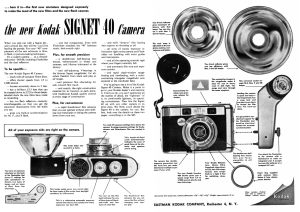
The Signet 35 was in production until 1958 and it’s sturdy metal body with large controls made it popular for military applications and those who needed to use the camera with gloves. In 1956 however, Kodak would release it’s successor, named the Signet 40. The Signet 40 was a completely redesigned camera, but kept the excellent triangular coincident image rangefinder and front shutter release, and added a more flexible 7-speed shutter, an all new Bakelite and metal body, a hinged rear film door, and a lever film advance. The Signet 40 came with two lens options, a 4-element Ektanar and a 3-element Ektanon lens. Both lenses had a focal length of 46mm and a maximum aperture of f/3.5. Perhaps the best feature of the Signet 40, was it’s lower $65 starting price. When adjusted for inflation, that compares to just over $600 today, making it within the reach of an average American family looking for a step up from simple box and point and shoot cameras.
The commercial below heavily promotes the Signet 40 as the ideal slide film camera. It lists the price as $74, which contradicts the earlier $65 price, so perhaps it dropped shortly after it’s release. It was positioned right in the middle of Kodak’s 35mm lineup between the scale focus Pony, and the German built Retina.
Edit 10/17/2022: The original YouTube video I linked to in this article is no longer available, but this one appears to show a similar commercial.
Although I could find no sales figures, the Kodak Signet 40 was probably pretty popular in the years it was available. It was discontinued in 1959 the same year as the Signet 30, but I feel that was less due to any shortcomings of the model but rather the change in the industry with “Electric Eye” cameras hitting the market that same year which greatly simplified photography with automatic exposure.
Throughout the 20th century, the Eastman Kodak Company was always a “film first” company, but maintained a catalog of capable cameras that they manufactured to help sell their film. The early 1960s would see a shift away from Kodak as a camera company as by 1962, the last American made Kodak 35mm camera would be discontinued. The German Retina series would continue until 1970, and after that only inexpensive 126 and 110 Instamatic cameras would be sold. In the 1980s, Kodak would reintroduce 35mm point and shoot cameras, but these would all be cheap Japanese made cameras sold under the Kodak name.
Today, despite many glowing reviews of cameras like the Signets 35 and 40, and their medium format Medalists and Chevrons, many collectors still “thumb their noses” at mid-century Kodak cameras. They don’t have the spectacle of German or Japanese cameras, but for someone looking to shoot an easy to use and well built 35mm camera, they definitely hold their own. While I’d never pay the same price for a Signet 40 as I might a Nikon, that doesn’t mean its not a worthy camera to add to any collection. In fact, considering these things often go unsold on eBay for prices as low as $10, I’d suggest that cameras like the Kodak Signet 40 represent one of the biggest bargains in the used camera market. Pick one up for yourself, shoot a roll through it, and let me know if you agree (or disagree)!
My Thoughts
A couple of months back, I was discussing American cameras with a fellow camera collector and he asked me if there were any American made 35mm rangefinders worth considering. Always one to root for the little guy, I immediately thought of cameras like the Argus C3, Perfex Forty-Four, or the Clarus MS-35. But each of those models make big compromises in either reliability or ergonomics for the new collector, so I thought about what I would consider to be a very good example of an American built camera with excellent optics, usability, and could often be find for very little on the used market, and I came up with the Kodak Signet 35, The Signet 35 was the first in Kodak’s Signet line which was introduced in 1951 as a mid-level choice for those looking for an easy to use camera with a good lens, but without the high prices that German models demanded.
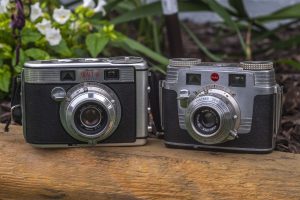
The Signet 35 certainly is an outstanding camera with a very distinct and handsome all metal body. It has a bright and easy to use coupled rangefinder with a unique triangular rangefinder patch, and came standard with Kodak’s excellent 4-element Ektar lens. In my review for the Signet 35 back in February 2016, I gave it very high marks for ease of use, high build quality, and an outstanding lens that rendered extremely sharp and contrasty images.
In the time since that review, I’ve explored other models in the Signet lineup, and they all seemed to go downhill from there. The Signet 80 is one that eluded me not once, not twice, but three times with examples that simply didn’t work. That model’s very poor reputation from a time when Kodak was right about to exit the camera-making business suggests that very few examples can be found in working condition today.
I’ve handled both the Signets 30 and 50, but never found them to be very special, or worthy of a full write up, leaving the Signet 40 as the last in the series for me to look at. Released five years after the Signet 35, the Signet 40 looks almost nothing like it’s older brother. The body is made almost entirely out of Bakelite compared to the mostly metal body of the Signet 35, but despite the more liberal use of plastic, both cameras feel close to the same weight. My wife’s kitchen scale confirms there isn’t much of a difference between the Signets 35 and 40, which weigh 495 and 470 grams respectively.
Aside from the cosmetics, the Signet 40 loses the 4-element Ektar lens, and comes with either a 3-element Ektanon or a 4-element Ektanar. The Ektanars are quite uncommon, so most examples have the Ektanon triplet like the one I have here. The shutter is changed, adding both a slower 1/5th and 1/10th speed and top 1/400th speed to the Signet’s simpler 4 speed shutter. Instead of knob wind, the Signet 40 uses a triple-wind film advance lever (yes, triple, as in you move the lever 3 times to advance one exposure), and a larger rewind knob with an easy grip handle for faster rewind. Finally, instead of a completely removable film back, the Signet 40 switches to a left hinged door with an early form of quick loading that is a slight improvement over the Signet 35’s method.
Both cameras have a ball-bearing unit focus for extremely smooth operation, an excellent coupled rangefinder with a triangular coincident image patch, and a comfortably located front shutter release lever.
The overall layout of the Signet 40 is pretty straight forward. The top plate of the camera is the most interesting with a very large, but very limited exposure calculator. It suggests f/stops for three different kinds of Kodak films in three different lighting conditions for a single 1/50th shutter speed. This dial also doubles as the rewind knob. To the right of this dial is the manually resetting exposure counter and a film reminder dial. Like the Kodak Retina series, the exposure counter counts backwards, showing the exposures left on the roll, but unlike the Retina, will not prevent the shutter from firing when it reaches 0.
The bottom of the camera has only the tripod socket, but if you look near the edges, there is an engraved indicator for two little levers. The lever facing the rear of the camera is marked “REWIND” and is used when you’ve reached the end of the roll and need to rewind the film. The one on the front of the camera is marked “RELEASE” and is used for intentional double exposures. From my experience, these two levers do the exact same thing, so I am not sure why Kodak put two levers for the same function on the camera. The user’s manual doesn’t make it obvious either.
Finally, on the side of the camera is the connector for the Kodak Kodalite flash gun. The manual specifies that both 3 and 4 inch flashguns may be used. The Signet 40 is synchronized for flashbulbs at 1/25th of a second, and electronic flashes at all speeds.
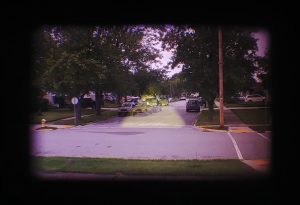
My favorite feature of the Signet 40 is the viewfinder with it’s triangular rangefinder system. The main part of the viewfinder has a prominent purple tint to it and the rangefinder patch is yellow, giving excellent contrast between the two making for easy focus measurement. This is the same exact system as found in the Signet 35 and one that I previously gave high remarks to in my review for that camera.
The greatest thing in my mind about the Signet 40 is that although this was never intended to be a top of the line model, everything comes together and works really well. Sure, the triple wind advance lever is a bit excessive, but otherwise the camera works just as well as rangefinder cameras costing a lot more. With a well built and easy to use body, and Kodak’s good 3 and 4-element lenses, this should be a pretty fun camera that makes good photographs, right?
My Results
Recently, Fuji discontinued their 4 packs of Fuji 200 and 400 films, and as a result, Wal-Mart had put all of the film on clearance at “stupid-low” prices, and I stocked up. I think the 4 packs of 200 were selling for $3.50 so I went to as many local stores as I could find and bought out their stock. I apologize to anyone reading this in the south suburbs of Chicago or Northwest Indiana as all that film is now sitting in my fridge!
Now that I have a pretty good supply of Fuji 200 and 400 films, I will be using it a lot more for trial films. I find that the film is pretty predictable and has a decent amount of latitude. About the only thing I don’t like about it is the frequent blue hue that outdoor pictures often have, but beggars cant be choosers, as they say.
In any case, the first roll through the Signet 40 was with Fuji 200 this past summer and here are the results.
The release of this review immediately follows my review for the Kodak Bantam Special, a top of the line camera made by Kodak in the 1930s with a German shutter and Kodak’s top of the line 6-element Ektar f/2 lens. The Bantam Special remains a highly sought after collector’s item that regularly sells upward of $250 in good condition.
In contrast to that camera, the Kodak Signet 40 is an under the radar camera that rarely attracts interest by collectors and regularly goes unsold on eBay for prices as low as $10.
This highlights one of the oddities of the camera collecting world, desirable does not always mean capable. While I caught a bit of grief for my general disdain for the Bantam Special, I have nothing but praise for the Signet 40. The images are sharp and show excellent contrast. Edge softness is visible but not distracting. Vignetting is non-existent even in well lit outdoor photos. The 7 speed shutter and smooth shutter release allowed for hand held shots indoors with slow shutter speeds. The excellent triangular rangefinder allowed me to get sharp, correctly focused shots in all lighting situations.

I mentioned earlier in this article about a discussion I once had about what was a good 35mm American rangefinder, and upon further reflection, calling the Signet 40 a “good” camera does it injustice. This is a GREAT camera! It has absolutely everything that I look for when it comes to a fun, capable, and reliable camera, regardless of who made it. These things were designed to be easy to use for non professional photographers in the 1950s, and their thoughtful design and easy controls make them extremely user friendly today. The coupled triangular rangefinder works incredibly well making focus a snap. The minimum focus distance of 2 feet allows you to get closer than most 35mm rangefinders do. The coated 3-element lens is on par with the best triplets made by Zeiss, Schneider, or any Japanese company in the 20th century. If you can find a Signet 40 with the 4-element Ektanar, it gets even better.
Some people suggest that the shutters on these Signets are not reliable as they can get dirty easily, and that might be true, but in my experience I have never seen a Signet 35 or 40 that didn’t work. I might just be lucky, but I have to think their simple designs are just not as prone to failure as other shutters of the era.
If I had one nitpick of the camera, it’s that the triple-wind film advance is a bit silly, but it doesn’t ruin the shooting experience and might even have a side benefit of reducing the possibility of tearing the film like some high torque cameras like the Anscomark M.
I may not have loved the Bantam Special, but that’s not because I don’t like Kodak cameras. This is a fantastic camera, and whether you are a collector who never shoots his or her cameras, or if you like to use them too, the Kodak Signet 40 absolutely belongs in your collection. If you’re on your way to eBay right now to look for one, you should probably pick up a Signet 35 as well!
Related Posts You Might Enjoy
External Links
http://camera-wiki.org/wiki/Kodak_Signet_40
https://blog.jimgrey.net/2011/04/18/kodak-signet-40/
https://www.broilkingbbq.com/EU/UK/grills/signet-series/signet-40.html (yes, I know this is a grill, but I thought it was funny!)
https://www.photo.net/discuss/threads/kodak-signet-40-%E2%80%93-clear-sailing.435133/
https://scotthuckphoto.wordpress.com/2013/08/01/mid-week-camera-review-week-11-kodak-signet-40/
https://filmphotographyproject.com/podcast/2014/05/film-photography-podcast-episode-103-may-15-2014/

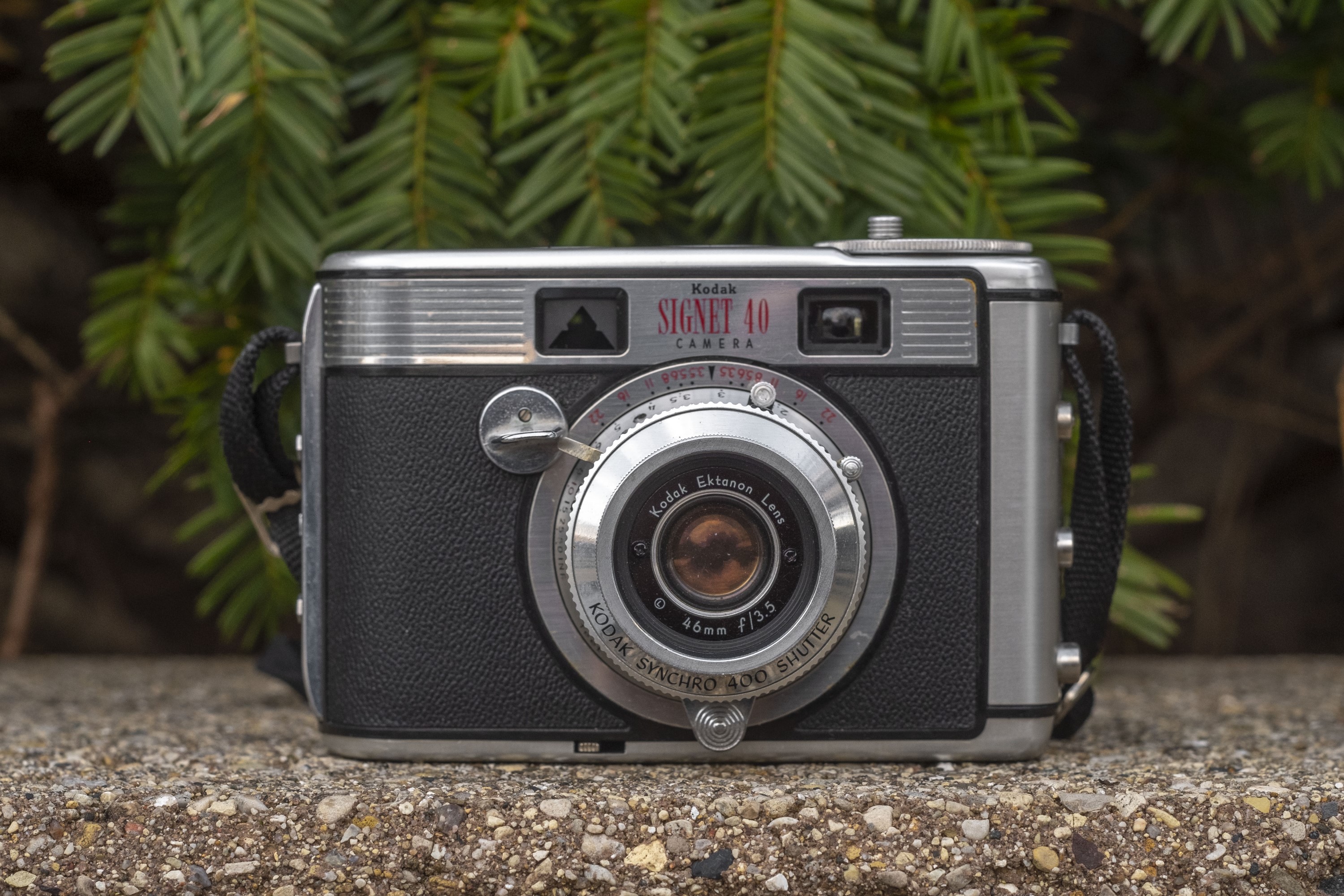
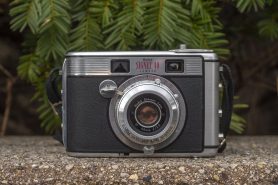
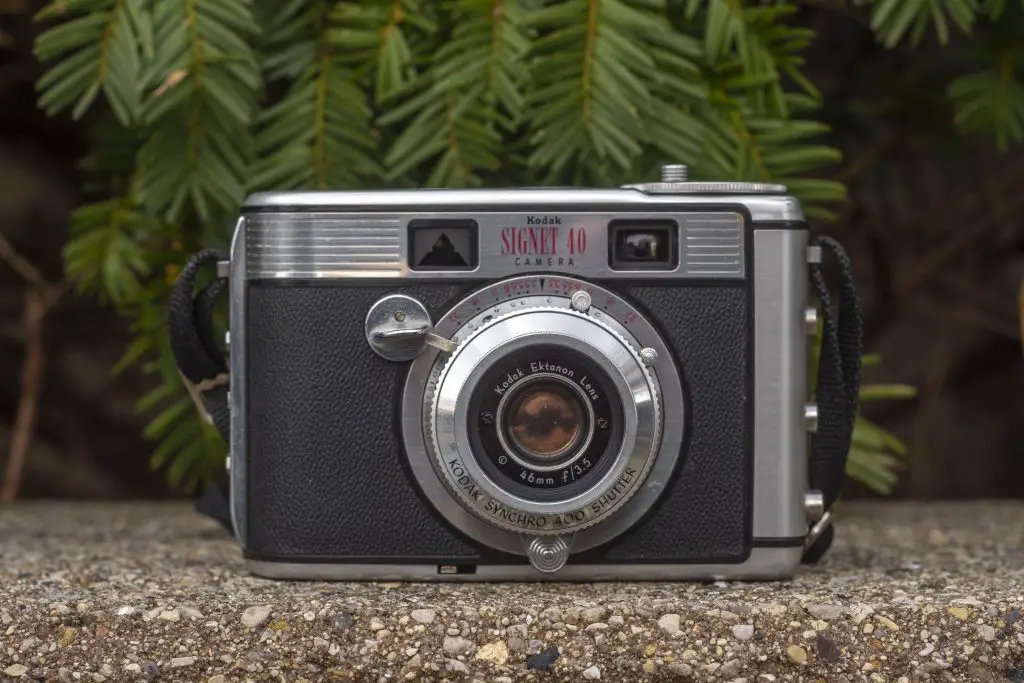


















i’m awed by the performance of that triplet lens. Wow! Appreciate your degree of depth in comparing & contrasting it to the Signet 35, which I have shot and enjoyed.
Nice write-up on the Signet 40.
The Signet 40 was a worth successor to the Signet 35. Some of the other Signet models bordered on junk, including the much-heralded Signet 80 with interchangeable lenses. Some Kodak cameras were quite good, and others were just not good at all.
I’m working on one now, and for the life of me, I can’t figure out how to remove the rewind knob from its post. I think that I have to remove the exposure disk. I think that I’ll need the heat gun to loosen the glue. This should be fun.
The shutter on the Signet 40 is very much like the one from the Signet 35 with the addition of 1/10 and 1/5.
Hey Mike, glad to see you comment on one of my reviews! I’ve been a long time fan of your site and have used your reviews as reference on things in the past.
I definitely agree the Signets 35 and 40 are worthy cameras, unlike others from the line. The Signet 80 has an awesome viewfinder, but otherwise is a hunk of junk. They almost always don’t work and every one I’ve come across has had issues with their shutter, which as best as I can tell are made out of a type of metal barely harder than Play-Dough.
It’s been a couple of years since I messed with the Signet 40, but I do recall struggling with the rewind knob. I couldnt get it off either, but just remember being able to get the top plate off just enough to be able to rotate it 90 degrees with the knob still on, so I could get in there and clean the viewfinder. Every one of these I’ve ever come across have had hazy viewfinders, but they are easy enough to wipe clean once you get the lid off.